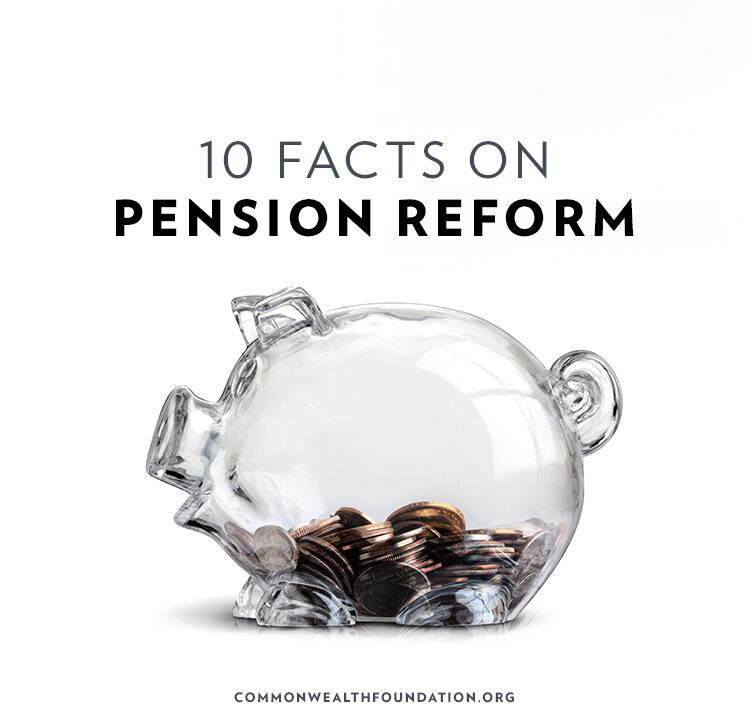Fact Sheet

Ten Facts on Pension Reform
Pension costs are ballooning, threatening to consume funds for education, public safety and welfare. Without timely reform, Pennsylvanians will face cuts to services, teacher layoffs, and higher property taxes. Yet there is widespread confusion about the impact of pension reform.
#1: There’s no denying Pennsylvania has a pension crisis.
Pennsylvania may soon be unable to meet its pension obligations, according to a Mercatus study. Without additional contributions, Pennsylvania’s Public School Employees’ Retirement System (PSERS) will have only a 31% chance of sufficient funding by 2030 and the State Employees’ Retirement System (SERS) will have only a 16% chance.
Meanwhile, the Independent Fiscal Office estimates that pension payments in 2019-20 will represent 9.4% of the state General Fund budget or $3.3 billion. That’s more than double the share of pension payments in the 2011-12 budget—crowding out funding for other services.
#2: The pension crisis was caused largely by politics.
Just 14 years ago, Pennsylvania’s public pension plans enjoyed a surplus—now they are more than $50 billion in debt. What happened? Lawmakers, spurred on by special interests like the Pennsylvania State Education Association, retroactively increased benefits and then passed legislation on three occasions to short-change pension payments. Stock market losses in 2001 and 2008 accelerated the accumulation of debt.
#3: The pension crisis is driving property tax hikes.
About 98% of school districts raising property taxes above inflation got exemptions for pension costs. Since 2008-09 the average household/homeowner has paid more than $600 in higher property taxes due to pensions, an unfortunate trend which will continue.
#4: Without reform Pennsylvania and its municipalities face insolvency.
After filing for bankruptcy, Detroit took the unprecedented measure of cutting pension benefits for retirees. Some retirees will see a 4.5% cut in benefits. Pensions were previously considered untouchable, but federal courts ruled the cuts were allowed under bankruptcy.
It’s unclear how the courts would rule on changes to future benefits of current employees. Within the past three years, at least 24 jurisdictions have faced lawsuits alleging that pension reform measures are unconstitutional.
#5: Legislative pension reform proposals give new state workers a defined contribution plan, such as a 401(k), rather than a defined benefit plan.
The vast majority of private sector workers maintain a 401(k) plan where the workers own their retirement and maintain long-term control over their investments. Public employees should not have to worry if the state will make good on its pension funding promises.
#6: Defined contribution plans can provide a secure and attractive retirement.
Claims that pension reform is “stealing teachers’ pensions” or “destroying the middle class” characterize a head-in-the-sand approach that ignores the reality that current plans can be raided or underfunded.
Defined contribution plans can provide a substantial replacement income at retirement when workers invest their entire careers. These plans offer employees other advantages, such as portability when changing jobs and ownership over their retirement account.
A defined contribution retirement would also correct the bias against new employees. Currently, benefits for long-term workers are partly paid at the expense of those who leave the public sector earlier. For example, fewer than 25% of Pennsylvania’s teachers ever become vested in the pension system, compared to a national median of approximately 45%, according to a study by Bellwether Education Partners.
#7: Defined contribution plans have predictable and affordable costs.
Rather than being subject to political manipulation and dependent on unknowns such as life expectancy and stock market returns, defined contribution plans make the employer responsible for a specified contribution each year. Unlike pensions, defined contributions plans are by definition fully-funded and cannot accrue unfunded liabilities.
#8: Giving new state workers defined contribution plans will not reduce the $50 billion debt.
Pension reform involves both fixing a broken system and paying down the debt. Both parts are essential, but stopping the accrual of debt and establishing a predictable system for new employees is a critical first step. We have to stop digging before we can fill in the hole.
#9: There are no transition costs when converting to a defined contribution plan.
Opponents claim government-mandated rules that require Pennsylvania to pay off unfunded liabilities sooner will cost the state, but the national Governmental Accounting Standards Board regulates only the accounting methods—it doesn’t mandate when or how debt must be paid. This “transition costs” argument has been repeatedly debunked by credible pension experts.
Virtually every private company, including most of the Fortune 500, has converted employees into a defined contribution plan without having significant transition costs. And states that have made the conversion have the same assumed rates of investment return for their closed defined benefit plans and their open defined benefit plans.
#10: Pension obligation bonds will make the pension crisis worse.
Issuing a pension obligation bond is like taking out a second mortgage on your house, investing the money in the stock market and hoping for a greater investment return. Moody’s Investor Service has warned state and local governments against such borrowing to finance underfunded pension systems. In the past three years, Pennsylvania’s bond rating has been downgraded four times.
###
To learn more about Public Pension Reform, visit CommonwealthFoundation.org.